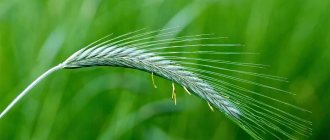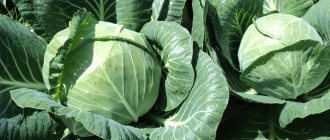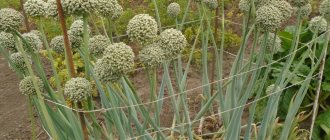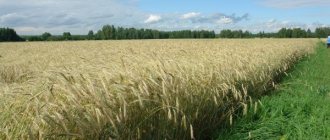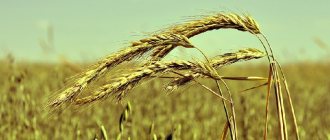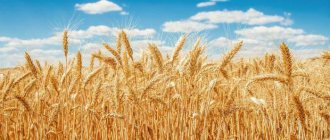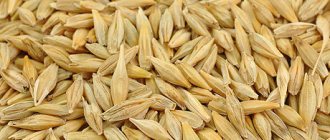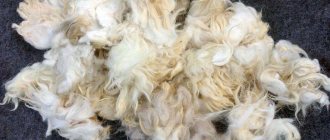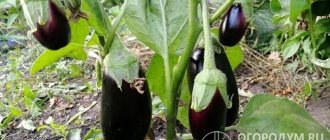In former times, ryeRye is an annual (biennial) herbaceous plant of the Evil family... was the main grain crop of Europe. Today, its role has been taken by wheat, while rye. Cultivated rye is an annual (biennial) herbaceous plant of the Evil family... is content with third place in terms of grain harvest volume, second even to barley. However, given its high endurance and adaptability to cold climates, it remains a fairly important agricultural plant for Russia.
Description of spring rye
Spring rye is one of the forms of seed rye. Unlike the winter form, which is sown in the fall before winter, spring rye is sown in the spring. The word “yarovaya” comes from the name Yarila, the god associated with the sun and the awakening of nature. Spring rye is harvested in late summer or early autumn.
Rye is an aggressive plant that can suppress any weed. Only cornflowers grow in rye fields. Advantages of rye of any form - spring or winter, compared to wheat:
- more resilient and unpretentious;
- higher resistance to diseases and pests;
- high resistance to lodging;
- is an effective green manure - improves the structure and condition of the soil;
- active phytosanitary – suppresses weeds.
Botanical description of spring rye:
- Root system. The fibrous roots penetrate 1-2 m deep. It grows on difficult soils. High digestibility of nutrients. The plant is characterized by intensive tillering. About a dozen shoots grow from one grain, and with good care - 5-10 times more.
- Stem. It is a hollow tube with several internodes - from 3 to 7. The stem is pubescent, straight, pubescence is present only directly under the ear. The average height of the stem is 0.8-1 m.
- Leaves. The length of the flat leaf is 15-30 cm. The leaves are narrow – no more than 2.5 cm in width. The leaf blade at the top is pubescent - this is an indicator of resistance to moisture deficiency.
- Inflorescence. The ear is elongated, unbreakable, with a strong axis. The length of the spike is 5-15 cm, the width is 0.8-1.2 cm. The awns of the spike are rough, the length is 3-5 cm. The anthers of flowers with three stamens protrude from the spikelet. Flowers are pollinated by wind.
- Corn. The shape is elongated, oblong, with a longitudinal groove in the center. The embryo is clearly visible. The surface of the grain is slightly wrinkled. Rye grain size: length – 4-10 mm, width – 1.5-3.5 mm. The weight of 1000 grains is 12-45 g. The grain of spring rye is smaller than that of winter rye. Rye grain is similar in chemical composition to wheat grain, but there are also differences. Rye grain contains less protein than wheat grain, but has more globulins and albumins. It also has less gluten and is of lower quality than wheat. The grain is yellow, gray-green, brown and reddish in color.
Rye cultivation technology
The conditions for growing rye should be aimed at obtaining a high yield. In order for rye to grow well, you need to maintain proper crop rotation. It includes the selection of high-quality seeds, soil cultivation, compliance with sowing dates, plant care, disease control and fertilization. Intensive cultivation technology also includes measures to preserve moisture in the soil.
To obtain a high yield at lower physical costs, winter and spring rye are sown after the predecessor plants. For winter varieties this is:
- Lupine and clover;
- Corn, peas and beans;
- Buckwheat;
- Early potato varieties;
- Spring wheat.
The best precursors are pure pairs. Spring varieties are less demanding of their predecessors. They grow well after perennial grasses, winter rye, rapeseed, clover and corn.
When planting seeds, take into account the seeding rate developed for the given region. For the Urals and Siberia this is 6.3 million per hectare, for non-chernozem regions - 6.5 million per hectare, for chernozem regions - 5.5 million per hectare.
Planting rye
Sowing consists of three stages:
- Seed preparation;
- Soil preparation;
- Sowing work.
For sowing, it is recommended to select only seed material. Feed and food grains do not provide good germination. For seeds of winter varieties, GOST defines the following indicators:
- Germination rate - from 92%;
- Purity - from 99%;
- Humidity - no more than 14%;
- Weight of 1000 seeds - not less than 35g;
- Growth power - over 80%.
Before sowing, grains are treated against rust, root rot, smut and stem smut. For this purpose drugs are used:
- Teagam;
- Vitatiuram;
- Fungicide;
- Hexatiuram.
If freshly harvested seeds are planted, they must be heated in the sun for 3-5 days or using a special grain dryer at a temperature of 45°C. Warm-up time: 3-4 hours. The process of preparing seed material includes several stages:
- Preliminary cleaning from coarse organic and mineral impurities;
- Drying;
- Cleaning from weeds and their seeds;
- Cleaning from grain impurities;
- Air-heat treatment (2-3 weeks before planting);
- Treating (10-16 days before planting).
To improve germination, seeds can be additionally treated with growth regulators and nutrients.
Soil preparation
After harvesting the predecessor, the fields are peeled to a depth of 8 cm. When harvesting the crop late or in cold weather, peeling is not necessary: it is replaced by applying manure and plowing to a depth of 30-35 cm. If the grain is planted after perennial grasses, then the soil is first disced and then plow with skimmers. After harvesting legume-oat mixtures and when the soil is wet, the soil is plowed to its full depth.
After the snow has melted and the soil has dried, harrowing and cultivation are carried out twice. If the field is heavily weeded, one cultivation is replaced by the application of a herbicide.
For spring rye, the soil is prepared in the fall:
- After the vegetable predecessors, the main soil cultivation is carried out to a depth of 17 cm or with disc harrows to a depth of 13 cm;
- After one-year injuries and buckwheat, peeling is carried out. If the field is heavily weeded, cultivation and disking are required.
- Plowing of plowed land is carried out in the second half of August to reduce the level of weeds, accumulate moisture and preserve nutrients. In crop fields with a large number of stones, plowing is carried out with plows with protection of working parts, and for smooth plowing, reversible types of plows are used.
In early spring, the soil is cultivated according to the physical ripeness of the soil. Depending on the granulometric composition of the soil, it is first harrowed, and heavier types of soil require cultivation without the use of a harrow and to a depth of 6 cm.
Sowing methods
To plant seeds, 3 sowing methods are used:
- Narrow row, with a width between beds of about 8 cm;
- Solid;
- Cross.
For continuous and cross sowing, the distance between the ridges is 14-17 cm. The sowing depth depends on the crop variety and soil type. For spring varieties this is usually 3-5 cm. Winter rye is more demanding on planting depth, since its tillering nodes are formed near the surface.
Seeds are planted on moist soil:
- On heavy soil - 2-3 cm;
- At medium density - by 3-5 cm;
- On light - 5-6 cm.
In dry weather and dry soil, the planting depth is increased by 1-2 cm to avoid blowing out the seed. If the arable soil is not sufficiently moistened after sowing, then rolling is carried out. This allows the seeds to strengthen in the ground and raises moisture to the upper layers.
Sowing time
Sowing time depends on the region and weather conditions:
- In the southern regions, winter crops are planted from the 4th week of September until mid-October;
- In Siberia - from the first ten days of August to mid-September;
- In non-chernozem regions - from August 5 to August 30;
- In the southeastern regions - from August 15 to September 5.
When calculating planting dates, it is assumed that the autumn growth period lasts about 45 days. The volume of average daily temperatures in this period should be equal to 445-555°C.
Planting of spring rye begins when the soil is actually physically ready, when the top layer warms up to +2°C. The seeds survive frosts well down to -8°C. In the northern regions, rye usually begins to be sown in the second half of May, in the southern regions - at the end of April and at the beginning of May. In Siberia - in mid-May.
Demand for sowing
Typically, spring rye is used as a replacement for winter rye that has been damaged or died for some reason. The low demand for spring rye can be explained simply - it is weaker than its winter counterpart, less productive and not as resistant to environmental challenges.
There are 10 species in the rye genus, but only one species is cultivated - rye. All others are wild. Seed rye has 39 varieties, but in the Russian Federation only common rye is grown. Spring rye in Russia accounts for about 1% of all sown areas.
Rye - description of the plant
Cultivated rye (rye) is a herbaceous plant that can be either annual or biennial. It is cultivated rye that is widespread and grown all over the world, but most of all in the northern hemisphere.
Nowadays, it has become customary that the word “rye” means precisely the seed crop. Although, in addition to it, there are several other types of rye:
- African rye;
- forest rye;
- mountain rye;
- Vavilov's rye;
- Derzhavin's rye;
- Anatolian, etc.
In Russia, for example, you can find forest rye, which grows as wild grass.
Terrain and climate for growing rye
It is profitable to grow winter rye, as it is a frost-resistant plant that gives a good harvest. It can easily withstand winter temperatures down to minus 35°C. But if the climate in winter is very harsh, then winter rye will not withstand it. Therefore, spring crops are in demand where extremely severe frosts are observed in winter, preventing winter crops from surviving. That is why in the Far North they sow spring rye in the spring and completely abandon winter rye.
Spring rye is grown in regions with risky agriculture - in Transbaikalia, Central Siberia, and Yakutia (Republic of Sakha). The regions where the bulk of fields of spring rye are located, sown purposefully, and not for reseeding winter crops, are Buryatia and the Chita region.
Rye yield by region: interesting facts
The plant genus has 10 species. Nowadays, only the seed variety is cultivated, which includes about 39 varieties. It’s sad, but spring rye is planted only if winter rye has disappeared or been damaged. Moreover, it is relevant in areas where very severe frosts are observed. Therefore, in the cultivated areas of Russia, only 1% of all plantings are allocated to it.
What varieties are there?
Spring rye is in little demand in agriculture, which is why there are few varieties:
- Vyatka. An experimental variety developed specifically for the Volga-Vyatka region. Used for reseeding if winter rye dies. Refers to mid-season varieties. The average growing season is 100 days. The variety tolerates low temperatures well, germinates quickly, bushes quickly and forms tubes. If ripening occurs in rainy weather, the ears are often hollow or through the grain. If conditions are favorable, the yield is 40 c/ha. The variety is resistant to lodging, disease damage does not exceed the level of the winter form.
- Onokhoyskaya. A variety developed by Buryat breeders. Designed for the harsh conditions of Eastern Siberia. The plant is tall - it grows up to 2.5-3 m. There is a tendency to lodging. The leaves are narrow, bushiness is moderate. The ear is prismatic, large, the grain is large. The growing season is 130-140 days. If you sow the seeds in May, then at the end of September you can already harvest. The grain is elongated, shedding is insignificant. Color – gray-green, with yellow. 1000 grains weigh 24-30 g. Tolerates spring drought and frost. It is distinguished by its friendly shoots and rapid growth at the beginning of the growing season. Effectively suppresses weeds.
- Svitanok. Ukrainian variety bred on the basis of the Leningradskaya variety. It is a safety crop and is used for reseeding winter crops. The growing season is 120-130 days. The bush is erect, with a strong stem and light green leaves. Spike length – 8-10 cm. Plant height – 1.2-1.6 m. Large grain, weight of 1000 pieces – 40 g. High resistance to root rot, powdery mildew and snow mold. Disadvantage: lodging. The peculiarity of the variety is high yields on soils poor in nitrogen.
Chemical composition, trace elements, vitamins
Per 100 g of grains there are:
- proteins – 9.9;
- fats – 2.2;
- carbohydrates – 55.8;
- calorie content – 283 kcal.
The grains contain microelements: Mg, Ca, S, Cl, Zn, Fe.
Vitamins included: B7, E, B3, B5, B1, B6, B2, K, P.
Acid balance (pH) 4.3-5.5.
Beneficial features
Rye contains a lot of nutrients, but in past centuries it was considered a rough food for peasants and common people. Thanks to this cereal, poor people in Rus' survived during long and harsh winters.
Rye also has medicinal properties:
- has a beneficial effect on the cardiovascular system;
- strengthens the immune system;
- normalizes the functioning of the nervous system;
- affects the condition of the skin, hair and nails;
- improves blood circulation;
- normalizes the functioning of the gastrointestinal tract;
- reduces blood glucose levels.
For the healthy gastrointestinal tract of a healthy person, this cereal does not pose any danger and is perfectly digestible. It promotes weight loss by normalizing intestinal microflora, alkalizing the body and restoring normal metabolism.
Rye is added to the diet by diabetics, since its glycemic index is low: in sprouts - 34 units, in flour with bran - 32 units, in whole grains - 40 units.
Harm
Rye contains gluten, so it should not be consumed by people with celiac disease. For them, this substance is contraindicated, as well as for patients with gastrointestinal disorders - ulcers and gastritis with increased stomach acidity.
Seed preparation
In order for the shoots to be friendly and the harvest to be decent, grain is sown in soil treated according to agricultural technology and the seeds are properly prepared for sowing. Only well-developed grains are taken. To determine this indicator, seeds are tested for germination in laboratory conditions.
Minimum seed quality indicators:
- germination – from 93-95%;
- purity – 98.5%.
The permissible norm of weed seeds is 20 g per 1 kg of rye grains. Before sowing the seeds in the ground, they are dried under a canopy. The drying area should have good ventilation and direct sunlight on the grain. Drying time – 3-4 days. To dry the grain faster, they use drying chambers - here it is heated to 60°C, and the drying process lasts only 2.5 hours.
After drying, the grains must be pickled to prevent diseases and stimulate shoot growth. Grain from last year's harvest is used as seeds.
Application of culture
Cereal grains are ground into flour, from which bread and dietary buns are baked. Nowadays, rye baked goods are considered healthy and lower in calories than those made from wheat flour. In ancient times it was the food of the poor and was considered coarse and heavy.
Did you know? Pliny the Elder, a statesman of Ancient Rome (1st century BC), said that you can only eat rye bread when you are extremely hungry. And in the countries of the Ancient East, the plant was even considered a weed; in Persian, its name is “jou-dar” - one that clogs crops.
Bread kvass is one of the most popular drinks among the Slavs, and made from black bread it is also healthy and has less calories. In addition to baking flour, they produce starch, which is not inferior in quality to its potato counterpart. Alcohol is obtained from grain for the production of strong alcohol or for medical use. Rye beer is popular in Germany and Western Europe.
The cereal crop is used to make feed for livestock. Poultry are given sprouted seeds. The plant is an excellent green manure, which improves the soil structure and suppresses weeds. In the past, straw was used for roofing in homes; in some villages it is still used in the construction of outbuildings. The material is cheap, accessible and quite durable.
Important! Rye crops repel many pests, so the crop is often used as a precursor for growing agricultural plants.
Rye is a grain crop that occupies one of the main places in the agricultural industry. Products made from grain contain many useful elements necessary for the body.
Soil preparation
Soil preparation for spring rye includes:
- Autumn processing. In September-October, steam is prepared, the soil is plowed and processed with a flat cutter. Loosening depth – 26-30 cm.
- Spring processing. Harrow the soil to a depth of 5 cm. The task of harrowing is to break up the soil crust, destroy shoots, mold, weed seeds and the remains of dead plants. Thanks to harrowing during spring sowing, the yield of spring rye increases by 15-20%.
Nitrogen fertilizers are applied during pre-sowing tillage, and phosphorus fertilizers are applied during sowing.
Origin and distribution of the plant
There is still no single coherent version about the origin and cultivation of rye, only a lot of assumptions and hypotheses. Thanks to archaeologists and the artifacts found (writings, frescoes, fossils), it is known for certain that the ancient Egyptians, the peoples of Asia and India knew and cultivated culture already in the 4th century. BC.
Most scientists agree that the cereal originated on the territory of modern Iran and Turkey. The plant was eradicated as a weed that infests wheat and barley crops.
You may be interested in information about how buckwheat grows.
Over time, farmers noted the plant's resistance to cold and its ability to grow on poor soils and in mountainous areas. Since the crop grew practically unattended, did not require special participation of ancient farmers and survived where wheat and barley died en masse, it began to be cultivated. Due to its resistance to external factors, the cost of the harvest was low. All segments of the population could afford products made from rye grains, unlike wheat products.
Today, rye is grown in large quantities throughout almost the entire Northern Hemisphere, namely:
- North America;
- Canada;
- Scandinavian countries;
- Europe and Baltic countries;
- Russia;
- China.
Pay attention to the information on the use of buckwheat as green manure.
Optimal sowing dates
Spring rye seeds are sown in spring. Sowing occurs in the second half of May. More precise timing and depth of seed placement depend on climatic conditions:
- In the forest-steppe zone, sowing begins in the third week of May.
- In the steppe zone - in the fourth week of May.
- In the Far East - May 1-20.
- In Siberia – May 10-20.
The timing of sowing also depends on the early maturity of the variety. So, for example, in Eastern Siberian farms:
- early rye is sown on May 15-25;
- mid-season - May 5-15.
If the soil has warmed up and there is no promise of frost, sowing begins earlier.
Useful properties of rye grain
Not only flour is made from rye grains, but also flakes, bran, kvass, and strong alcoholic drinks. Different types of bread, crispbread, desserts, pastries and various sweets are made from flour. All these products are distinguished by their low calorie content and rich vitamin and mineral composition.
Chemical composition
Rye is much healthier than wheat or oats. Its protein contains many amino acids and some gluten. Rye contains a large amount of fiber, which improves intestinal function and hemicellulose.
Of the vitamins, 100 g of grains contains:
- Vitamin A - 1 mcg;
- Beta-Carotene - 0.007 mcg;
- Thiamine - 0.316 mg;
- Riboflavin - 0.250 mg;
- Choline - 30.5 mg;
- Pantheonic acid - 1.5 mg;
- Pyridoxine - 0.3 mg;
- Folates - 38 mcg;
- Tocopherol - 0.9 mg;
- Phylloquinone - 6 mcg;
- Betaine - 150 mg.
Macroelements are represented by calcium, potassium, magnesium, phosphorus and sodium. Microelements - iron, copper, selenium, manganese and zinc. Of the essential amino acids, grain contains:
- Valin;
- Histidine;
- Arginine;
- Leucine;
- Lysine;
- Threonine;
- Tryptophan;
- Methionine;
- Phenylalanine.
The non-essential amino acids in the product are aspartic and glutamic acid, alanine, serine, glycine, tyrosine and proline. The grain contains Omega-3 and Omega-6 fatty acids, saturated fatty acids - palmitic, stearic and myristic, monounsaturated fatty acids - palmitoleic, gadoleic and oleic, and polyunsaturated fatty acids - linolenic and linoleic.
What are the benefits of grain
Rye grain is an excellent natural antioxidant, anti-inflammatory and anti-allergenic agent. Rye products strengthen the immune system, improve blood circulation and the functioning of the intestines and cardiovascular system. Regular consumption of rye bread or crispbread, bran or flakes is a prevention of cancer.
Another beneficial property of rye grains is to cleanse the body of toxins. They also help in the treatment of respiratory diseases, gastrointestinal diseases, and eczema. Rye improves metabolic processes in tissues, the functioning of the lymphatic, endocrine, and nervous systems.
Rye flour products are prescribed during recovery after serious illnesses, operations, and childbirth. For diseases of the thyroid gland and heart disease, rye bread and bran must be included in the menu. A decoction of rye bran helps with atherosclerosis, diarrhea, tuberculosis and hypertension.
The benefits of sprouted grains
Nutritionists value sprouted rye for its rich vitamin composition. The concentration of minerals and nutrients in sprouted grain is several times higher than in dry grain. Regular use of the product increases emotional and physical endurance, increases activity, strengthens muscle and bone tissue, improves coordination of movements, memory, and concentration. Rye sprouts are recommended for diabetes, atherosclerosis, diseases of the gallbladder and gastrointestinal tract, diseases of the organs of vision. Sprouted rye is also included in the diet menu.
How to germinate rye
For germination, grain from the previous harvest and not treated with chemicals is selected. The seeds are washed several times with warm running water and placed on a tray covered with a damp cloth. The top of the grains is covered with another piece of cloth and filled with water. The liquid should cover the seeds by 1-2 mm. Every day, the seeds need to be washed and the water in the tray changed - otherwise oxidation and the development of mold or drying out cannot be avoided. The first shoots appear after 2-4 days. Before use, it is advisable to rinse the rye sprouts with cold water to eliminate the unpleasant odor.
Care and cultivation
Spring grain crops, including rye, quickly absorb nutrients. Yaritsa, having a shorter growing season than winter rye, consumes no less nutrients. Tillering in spring rye is less intense, and the root system is weaker than in winter crops - it is important to provide it with adequate nutrition, as well as protection from diseases and pests.
Feeding and processing
Fertilizer requirements of spring crops:
- Nitrogen. The greatest need for nitrogen fertilizers is observed at the beginning of tillering. During the time from tillering to emergence, the plant absorbs 40% of the total nitrogen consumed during the growing season. To obtain 1 ton of grain, about 30 kg of nitrogen fertilizers are needed. Nitrogen fertilizers are applied in three stages - in the spring during cultivation, at the single node stage and at the heading stage.
- Phosphorus. Spring plants require the most phosphorus during rapid growth. Phosphorus helps to form a strong root system, promotes the formation of a large ear and early ripening. Phosphorus does not provide such an increase in yield as nitrogen fertilizers, but without it plants develop poorly. To obtain 1 ton of grain, 11.5 kg of phosphorus is required. Phosphorus fertilizers are applied in the fall during fall plowing or in the spring during pre-sowing cultivation.
- Potassium. Spring crops need potassium most during the first growth period. To obtain 1 ton of grain, 25 kg of potassium is required. Potassium fertilizers are applied in the same way as phosphorus fertilizers - in autumn or spring.
Spring rye finishes absorbing nutrients when it approaches the heading and flowering period. The exact doses of mineral fertilizers for cultivating spring rye are calculated taking into account specific conditions. What matters is the type of soil, its composition, predecessor, and planned yield.
An important task of caring for rye crops is to prevent the appearance of weeds. Soil cultivation includes the following activities:
- Harrowing. Apply when seedlings reach the 2-3 leaf stage. If you are late with harrowing and the weeds become stronger and form true leaves, the effect of this agrotechnical measure will be small. In practice, harrowing to kill weeds is used extremely rarely.
- Herbicide treatment. The type and dose are selected depending on the types of weeds. Spring rye grows quickly, it effectively suppresses weeds, and there is not always a need to use poisons. If herbicides are still applied, this is done during the tillering phase. If you start processing earlier, there is a risk of damage to cultivated plants. Delay causes deformation of the ear and a decrease in yield.
Herbicides are used in the form of aqueous solutions. Processing time – early morning or late evening, at a temperature of no more than 20°C. Ground spraying is used.
An effective technique for growing spring crops is foliar fertilization with copper. If the soil has a pH level of more than 6.0, the crops are fed with manganese. Feeding time is at the stage of 1-2 knots. Dosage – 50 g copper/manganese per 1 ha.
Diseases, pests and prevention
Protection and prevention of plants from diseases and pests is the key to a high yield. Common rye diseases and measures to combat them are in Table 1.
Table 1
| Disease | Symptoms | Control and prevention measures |
| Stem smut | Stripes on the stem, leaves, ear. They are leaden at first, then germinate with black spores. |
|
| Cercosporella basal rot | Spots appear at the bottom. The plant in the affected areas breaks and lies down. The grains are underdeveloped. |
|
| Fusarium root rot | Tillering nodes and internodes of rye become brown, sometimes with a pink coating. The trunk tissues are destroyed and the plant dies. |
|
| Powdery mildew | The leaves and stems are covered with a white coating, followed by black dots. The plant dies. |
|
| Yellow rust | The leaf blades are covered with lemon spots. The causative agent is a fungus. |
|
| Rhynchosporiasis | The appearance of red-brown stripes on the leaves. |
|
Spring rye, like any cereal crop, needs protection from pests.
Without protective measures, crop losses reach 15%. The most dangerous pests and protective measures are in Table 2.
table 2
| Pest | Protection measures |
| Striped leafhopper | insecticides during the period of heading and milky ripeness of grain |
| Cereal aphid | control of wild cereals and the use of insecticides in May-June |
| The turtle is harmful | selection of resistant varieties and treatment of larvae with insecticides |
| Wheat thrips | early fall plowing, pre-sowing cultivation, compliance with crop rotation, and, if necessary, chemical treatment |
| Ground beetle | compliance with crop rotation, separate harvesting with quick windrow threshing |
| Striped bread flea | prompt sowing of spring cereals and treatment of crops with insecticides during the emergence of beetles from wintering |
| Gray cutworm | peeling and early plowing of plowed land, treatment of row spacing |
Winter rye processing
Winter rye is processed to produce flour. Depending on the processing technology, there are several types of flour:
- The sifted flour is white with a slight grayish tint. It is soft, finely ground and widely used in bakery enterprises.
- Peel flour has many more large particles and shells and is characterized by a gray-white color.
- Wallpaper flour is coarsely ground. It is gray and is as close as possible to seeds in composition.
Dough made from rye flour gradually darkens, which is why the bread differs significantly from wheat in color.
Harvesting
When harvesting rye, the crop’s tendency to overripe and shed is taken into account, so it is important to start the harvesting campaign in a timely manner. The main thing in harvesting rye is to start on time. If you delay harvesting by at least 10 days, significant crop losses are inevitable. On the other hand, work started too early leads to a shortage of harvest, since some of the grain is unripe.
It takes 10-20 days from the milky-waxy ripeness of the grain to its full ripening. When harvesting grain with a combine, the best option is to achieve full ripeness of the grain. The moisture content of grains to be used as seed material should not exceed 20%.
When choosing a harvest time, it is important to consider the maturity of the straw. If its humidity is high and the stems are long, the harvester is adjusted to these conditions. Wet and long straw wraps around the drum, making threshing difficult. If the crops are not dead and the weather is favorable, harvesting begins even if the grain is not ripe.
Immediately after threshing, the grain is sent to the grain cleaning complex - for drying and sorting. The grain is brought to marketable condition. After threshing, the straw is removed from the fields to prepare the soil for the future harvest.
Despite the low prevalence of spring rye, this crop occupies an important place in agricultural production. Spring rye varieties make it possible to grow bread in risky farming areas and insure the crop when winter rye freezes.
0
0
Copy link
When the rye blooms
The fields begin to bloom 7-10 days after heading . Flowering lasts up to two weeks. In hot weather, the period can be shortened to 6-8 days. With increased humidity and cold weather, the anthers do not open, and flowering lasts longer.
The flowers open several times during the day for 15-30 minutes, after which they close. The first buds bloom in the middle part of the ear, then flowering spreads to the edges.
When it is removed from the fields
Rye is harvested in the middle of the waxy ripeness stage . When harvesting, speed is important. When rye ripens, 4-6 days after the end of waxy ripeness, the grains begin to rapidly fall off, and the harvest is lost.
Benefits of rye as green manure
It is not by chance that rye is chosen as a green fertilizer. It promotes:
- improvement of soil microflora;
- creating a favorable environment for worms;
- loosening the soil and filling it with oxygen and moisture.
If rye is used as mulch, it also protects the soil from drying out and exposure to wind. A thick layer of mulch from cut plants retains moisture in the ground for a long time, which allows you to water the beds less often and significantly slows down the growth of weeds. Green manure also prevents the leaching of nutrients from the soil with precipitation.
The benefits of green organics
Green manures are natural organic fertilizers that provide natural nutrition and exchange of nutrients in the soil. Their main advantage is safety for the environment, which is why such plants are often grown in summer cottages. It has been proven that natural fertilizers can increase soil fertility in the garden several times. In addition, they contribute to the accumulation of nutrients in the soil, thereby providing nutrition and support to plants throughout the entire period of development.
Interesting facts about rye culture
Rye is the record holder among herbaceous plants for the length of the root system. Under good conditions and nutritious soil, the total length of the plant's roots can reach 500-600 km, occupying a large area (up to 250 sq.m). The weight of roots per hectare reaches 6000 kg. In nature, wild rye species can reach a height of 3 m.
Rye bread was an important part of the life of the Slavs. Rye was also used to feed livestock, roofs were covered with straw, mattresses were stuffed, and stoves were heated. Among the Slavic peoples, rye was associated with vitality and love of life, resistance to the forces of evil and the community of worldly life.
The origin of the word “rye” has several versions. According to one of them, the modern word became a derivative of the Old Russian “rye”, which is similar to the verb “to give birth”. For this reason, farmers still use the expression “the harvest is born” today. According to another version, the word “rye” comes from “rye”, which means sunny, bright, and has common roots with the name of the sun god in the beliefs of the Slavs (Yarilo).
Rye is the only grain crop that is cultivated in all climatic regions.
It is grown both in Yakutia, with cold and short summers, and in Colombia, with a hot and humid climate. It is also classified as a plant that quickly loses its germination capacity: after 3-4 years, rye seeds lose their ability to germinate by more than 70%.
Winter rye is grown in many regions of Russia. It is sown where wheat or oats will not produce a good harvest or will die from unfavorable conditions. The benefits of cereal are enormous: the grain is rich in a number of essential acids, vitamins, enzymes, micro- and macroelements. Rye is used not only in the food industry; it is a valuable feed crop, an effective green manure and a valuable raw material for the production of biofuel.
